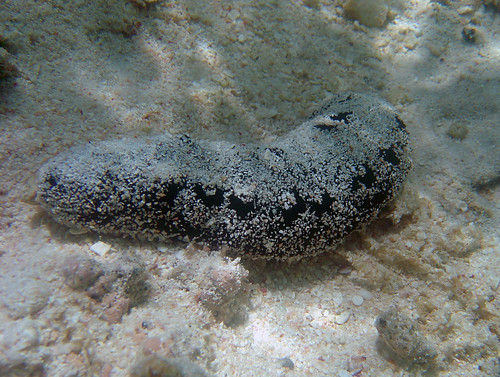Balate’ (sea cucumber)
The 19th century trepang trade was a profit-driven industry throughout the Pacific, most notably in Melanesia and the western Pacific, and lasted as a viable industry until the early 1940s. Today, it is a cottage industry in many parts of Melanesia.
Trepang is also known as beche-de-mer (Holothuroidea), a French term that means marine food product, and is a derivative of the Portuguese, bicho-do-mar. To the 21st century beachcomber, trepang is a sea cucumber (balate’ in CHamoru), a marine animal that is vital to the reef flat ecology – it serves as a natural vacuum, cleaning the waters of natural pollutants.
In the past, Guam waters contained at least 26 different varieties of the econoderm; today, only 14 to 15 species have been reported. For the early 19th century European or American trader, however, trepang served a different purpose – profit.
Trepang preparation
The sea cucumber, when dried and cured, was (and still is) a Chinese and Japanese epicurean delicacy used in soups; Chinese herbalists recommended cured trepang as an aphrodisiac, as well.
Early Chinese settlers introduced curing methods to the native populations of the Pacific islands and enjoyed the benefits of the trade by shipping the produce to China and other East Asian countries.
Historians indicate that the trepang trade on Guam began in approximately 1802, when the Spanish-chartered American bark, Lydia, dropped anchor at Apra Harbor to off-load supplies. Many other American ships would take advantage of Guam’s relative isolation – the Creoles revolutions in Central and South America at the turn of the 19th century ended the once lucrative Manila Galleon trade – and recognize the island’s strategic value for the burgeoning China trade. On Guam, the Spanish governor held a virtual monopoly on the trepang trade.
In the early 1800s, William Haswell, the Spanish-speaking first officer of the Lydia wrote about the trade:
Easily caught, cleaned, and smoked, the rubbery shrunken trepang skins were sacked up by the thousands and shipped from all over the Pacific to China, where they sold for ‘15 Spanish dollars [per] the hundred pounds.’
The processing method is simple and done in the same fashion as it was during the 19th century: the collected animals are cleaned, boiled, smoked, and then dried and packed for export to the main markets in Singapore and Hong Kong.
Trade demise in the Marianas
From the late 18th century and the early 19th century, the Spanish operating out of the Philippines continued to have a virtual monopoly on the trepang trade in the Pacific. By 1829, the monopoly was broken when American traders finally figured out how to cure the sea slug properly. Soon the Americans began to overwhelm the trade operating out of the Philippines.
American ships rarely visited Micronesia for trepang after the mid-1840s. Adding to the decline in Micronesia was that Americans were less likely to visit the Spanish-ruled Marianas and opted to do business in the South Pacific where they could gather items in addition to trepang, such as sandalwood, for trade with the Chinese.
For further reading
Hezel, Francis X., SJ. The First Taint of Civilization: A History of the Caroline and Marshall Islands in Pre-Colonial Days, 1521-1885. Honolulu: University of Hawai’i Press, 1983.
Sachithananthan, Kanapathipillai. Beche De Mer Industry in the South Pacific Islands: First Report to the Food and Agriculture Organization of the United Nations. Saipan: Marine Resources Division, Resources and Development Department, 1971.
South Pacific Commission. Beche-de-mer of the South Pacific Islands: A Handbook for Fishermen. Noumea: South Pacific Commission, 1974.





